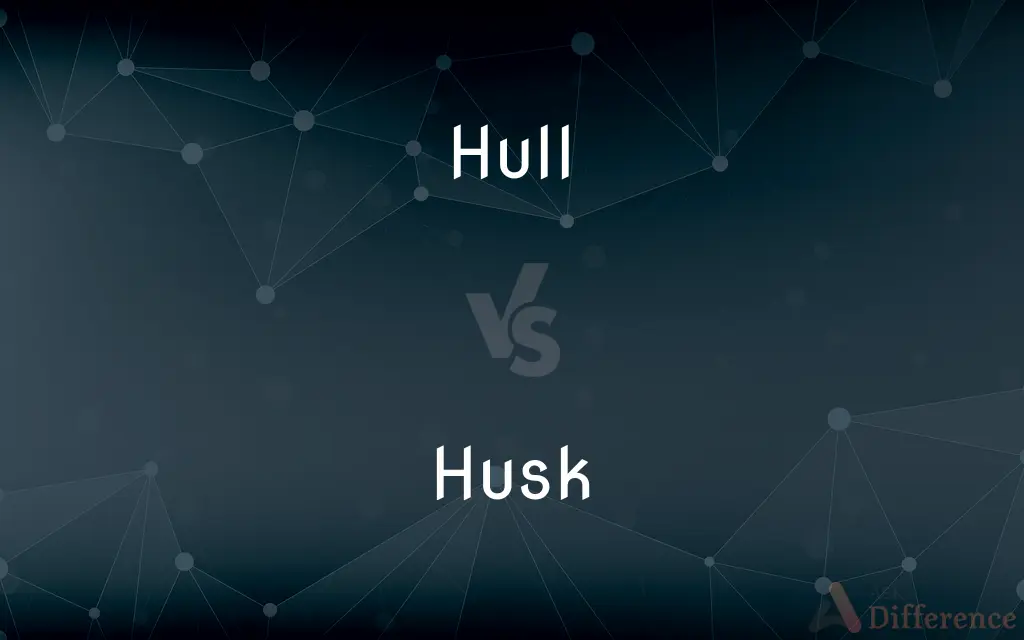Hull vs. Husk — What's the Difference?
By Tayyaba Rehman & Maham Liaqat — Updated on March 19, 2024
Hulls are the outer coverings of seeds or grains, often harder, while husks are usually lighter, dry outer coverings of certain fruits or seeds.

Difference Between Hull and Husk
Table of Contents
ADVERTISEMENT
Key Differences
Hulls and husks serve as protective layers for seeds and grains, but their texture and thickness can vary significantly. Hulls, typically found on seeds and grains like wheat and rice, are generally hard and need to be removed for consumption. On the other hand, husks, such as those surrounding corn or coconut, are more fibrous and sometimes can be peeled away by hand.
While hulls are integral to grains and are often removed during milling to make the grain edible, husks may not always be directly attached to the seed or grain itself but rather serve as an additional protective layer. For example, the husk of a coconut provides insulation and protection from physical damage.
The process of removing hulls, known as hulling or dehulling, is crucial for many grains to become edible or for further processing into flour or meal. Whereas, husking, the process of removing husks, is often less labor-intensive and sometimes can be done without specialized machinery, as seen with corn.
Hulls are often considered waste in food processing and are used for animal feed, bedding, or even as a biofuel source. Husks, due to their fibrous nature, find uses in crafting, as a potting medium in horticulture, or even as natural sponges.
In some contexts, the terms hull and husk are used interchangeably, especially in casual conversation. However, in agricultural and botanical contexts, the distinction is more pronounced, with hulls referring more to the hard outer layers of grains and husks to the outer coverings of seeds or fruits with a more fibrous texture.
ADVERTISEMENT
Comparison Chart
Definition
The outer covering of a seed or grain, often hard.
The outer covering of certain fruits and seeds, usually dry and fibrous.
Texture
Hard and tough, requiring mechanical processing to remove.
Dry and fibrous, can often be removed by hand.
Example
Rice hulls are removed to obtain the edible grain.
Corn husks are peeled away to reveal the cob inside.
Uses after removal
Often used as animal feed or in biofuel production.
Used in crafting, as a potting medium, or as a natural sponge.
Processing
Called hulling or dehulling.
Known as husking.
Compare with Definitions
Hull
Hulling is necessary for consumption.
Hulling machines are essential in grain processing plants.
Husk
Light, dry, and sometimes easily removable.
Corn husks are used to wrap tamales because of their natural flexibility.
Hull
Common in grains like wheat, rice, and barley.
Barley hulls are a by-product of the malting industry.
Husk
Found in fruits like coconut and in corn.
Rice husks are also used as a biofuel source.
Hull
The outer covering of a seed or grain, typically hard.
The hull of the wheat needs to be removed to make it edible.
Husk
Husking can be manual or mechanical.
Husking corn by hand is a common task during harvest season.
Hull
Used in animal feed or as biofuel.
Discarded hulls are often ground into feed for livestock.
Husk
The outer, often dry and fibrous layer of certain seeds or fruits.
The husk of a coconut protects its inner flesh.
Hull
Often hard and tough, made for protection.
Rice hulls are incredibly durable and often used in construction materials.
Husk
Craft material, in horticulture, or as natural sponges.
Coconut husks are processed into coir, used in gardening.
Hull
The dry outer covering of a fruit, seed, or nut; a husk.
Husk
Husk (or hull) in botany is the outer shell or coating of a seed. In the United States, the term husk often refers to the leafy outer covering of an ear of maize (corn) as it grows on the plant.
Hull
The persistent calyx of a fruit, such as a strawberry, that is usually green and easily detached.
Husk
The outer membranous or green envelope of some fruits or seeds, as that of a walnut or an ear of corn.
Hull
(Nautical)The frame or body of a ship, exclusive of masts, engines, or superstructure.
Husk
A shell or outer covering, especially when considered worthless.
Hull
The main body of various other large vehicles, such as a tank, airship, or flying boat.
Husk
A framework serving as a support.
Hull
The outer casing of a rocket, guided missile, or spaceship.
Husk
To remove the husk from.
Hull
To remove the hulls of (fruit or seeds).
Husk
The dry, leafy or stringy exterior of certain vegetables or fruits, which must be removed before eating the meat inside.
A coconut has a very thick husk.
Hull
The outer covering of a fruit or seed.
Husk
Any form of useless, dried-up, and subsequently worthless exterior of something.
His attorney was a dried-up husk of a man.
Hull
Any covering.
Husk
The supporting frame of a run of millstones.
Hull
The body or frame of a vessel, such as a ship or plane.
Husk
An infection in cattle caused by a species of Dictyocaulus or lungworm
Hull
The smallest set that possesses a particular property (such as convexity) and contains every point of A; slightly more formally, the intersection of all sets which possess the specified property and of which A is a subset.
The orthogonal convex hull of an orthogonal polygon is the smallest orthogonally convex polygon that encloses the original polygon.
Holomorphically convex hull; affine hull; injective hull
Husk
(transitive) To remove husks from.
Hull
To remove the outer covering of a fruit or seed.
She sat on the back porch hulling peanuts.
Husk
(intransitive) To cough, clear one's throat.
Hull
To drift; to be carried by the impetus of wind or water on the ship's hull alone, with sails furled.
Husk
(transitive) To say huskily, to utter in a husky voice.
Hull
(transitive) To hit (a ship) in the hull with cannon fire etc.
Husk
The external covering or envelope of certain fruits or seeds; glume; hull; rind; in the United States, especially applied to the covering of the ears of maize.
Hull
The outer covering of anything, particularly of a nut or of grain; the outer skin of a kernel; the husk.
Husk
The supporting frame of a run of millstones.
Hull
To strip off or separate the hull or hulls of; to free from integument; as, to hull corn.
Husk
To strip off the external covering or envelope of; as, to husk Indian corn.
Hull
To pierce the hull of, as a ship, with a cannon ball.
Husk
Material consisting of seed coverings and small pieces of stem or leaves that have been separated from the seeds
Hull
To toss or drive on the water, like the hull of a ship without sails.
Husk
Outer membranous covering of some fruits or seeds
Hull
Dry outer covering of a fruit or seed or nut
Husk
Remove the husks from;
Husk corn
Hull
Persistent enlarged calyx at base of e.g. a strawberry or raspberry
Hull
United States naval officer who commanded the `Constitution' during the War of 1812 and won a series of brilliant victories against the British (1773-1843)
Hull
United States diplomat who did the groundwork for creating the United Nations (1871-1955)
Hull
A large fishing port in northeastern England
Hull
The frame or body of ship
Hull
Remove the hulls from;
Hull the berries
Common Curiosities
Can you eat hulls or husks?
Generally, no. Hulls and husks are removed before consumption due to their tough or fibrous nature.
Can hulls be used after removal?
Yes, hulls are often used as animal feed, in biofuel production, or as bedding.
How are hulls removed from grains?
Through a process called hulling or dehulling, which often requires mechanical processing.
Are husks useful after being removed?
Yes, husks have various uses including in crafts, as potting medium in horticulture, or as natural sponges.
Do all grains have hulls?
Most grains have hulls, which are removed to make the grain edible.
Is the process of removing husks similar to hulling?
Husking can be less labor-intensive and is sometimes done by hand, unlike hulling, which usually requires machinery.
What is the primary function of hulls and husks?
Both serve as protective layers for seeds and grains, though hulls are generally harder and attached to grains, while husks are more fibrous and surround certain fruits or seeds.
Can hulls and husks be composted?
Yes, both can be composted, though their decomposition rates vary.
Do hulls and husks have nutritional value?
They are not typically consumed for their nutritional value but may have uses in animal feed.
What are some examples of husks?
Corn husks and coconut husks are well-known examples.
Are hulls and husks considered waste?
While often by-products of processing, they are not wasted and find uses in various industries.
How do the textures of hulls and husks differ?
Hulls are generally harder and tougher, while husks are more fibrous and sometimes lighter.
Why are husks important for some plants?
They provide protection from environmental factors and pests.
What are some examples of hulls?
Rice hulls, wheat hulls, and barley hulls are common examples.
What happens to hulls during milling?
They are removed to access the edible part of the grain.
Share Your Discovery

Previous Comparison
Tycoon vs. Mogul
Next Comparison
Event vs. OccasionAuthor Spotlight
Written by
Tayyaba RehmanTayyaba Rehman is a distinguished writer, currently serving as a primary contributor to askdifference.com. As a researcher in semantics and etymology, Tayyaba's passion for the complexity of languages and their distinctions has found a perfect home on the platform. Tayyaba delves into the intricacies of language, distinguishing between commonly confused words and phrases, thereby providing clarity for readers worldwide.
Co-written by
Maham Liaqat













































